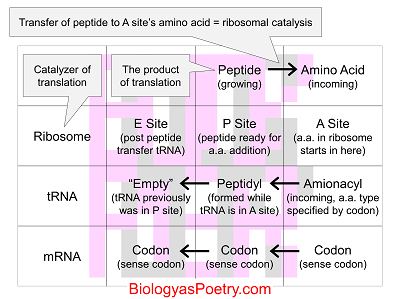∞ generated and posted on 2016.02.06 ∞
Conversion of specific RNA sequences into specific amino acid sequences to produce polypeptides.
Messenger RNA (mRNA) carries the information encoded by genes to ribosomes which then "read" the nucleic acid-based and "" it into to amino acid-based information.
Transfer RNAs (tRNAs) are responsible for the actual conversion of one form of information into another, serving in a sense as where the word in one points to the equivalent word in the other language.

Figure legend: Translation in outline. Messenger RNAs provide a code (in codons) that is interpreted by tRNAs within the context of ribosomes. There amino acids are polymerized into specific polypeptides with specific sequences and specific lengths, all as specified by mRNA sequence (which in turn was specified by DNA sequence, that of genes). The aminoacyl tRNA synthases are a category of enzymes that are responsible for making sure that the correct amino acid is associated with specific tRNAs.
The overall process can be distinguished into three basic steps, translation initiation, translation elongation, and translation termination. In addition to ribosomes, mRNA, and tRNA, also involved are aminoacyl tRNAs, aminoacyl-tRNA synthetases, and .

Figure legend: Process of translation shown in tabular form. Messenger RNAs move right to left, as depicted here, carrying the tRNAs associated with each codon along with them (leftward-pointing arrows). This tRNA movement is relative to the fixed in place A site, P site, and E site, which are associated with the otherwise stationary ribosome. The ribosome's catalytic activity involves movement of the peptide attached to the tRNA found in the P site (that is, as associated with the peptidyl tRNA) to the A site and then forming a peptide bond between the amino acid found in the A site with the peptide formerly associated with the P site. The result is that the aminoacyl tRNA located in the A site is converted to a peptidyl tRNA while still located in the A site, but then both this peptidyl tRNA and the now 'empty' tRNA found in the P site are moved leftward. The result is an exiting of the empty tRNA from the ribosome (via the E site), movement of the now one amino-acid longer peptidyl tRNA to the P site, and an emptying of the A site so that an additional aminoacyl tRNA may be acquired by the ribosome.
Because of the switch from one language to another, translation is a far more complicated process to catalyze than either transcription or replication. The role mRNA, ribosomes, and polypeptide products in translation nevertheless are analogous to DNA, RNA polymerease, and RNA in transcription (template, catalyst, product, respectively) and DNA (template strand), DNA polymerase, and DNA (daughter strand) in DNA replication.
The following video is a nice computer animation of part of the central dogma of molecular genetics:
A "flaw" in the following video is that it doesn't explicitly show amino acid transfer from the tRNA to the growing polypeptide chain, nor does it show the E site, but still it is a nice addition to the animations depicting translation: